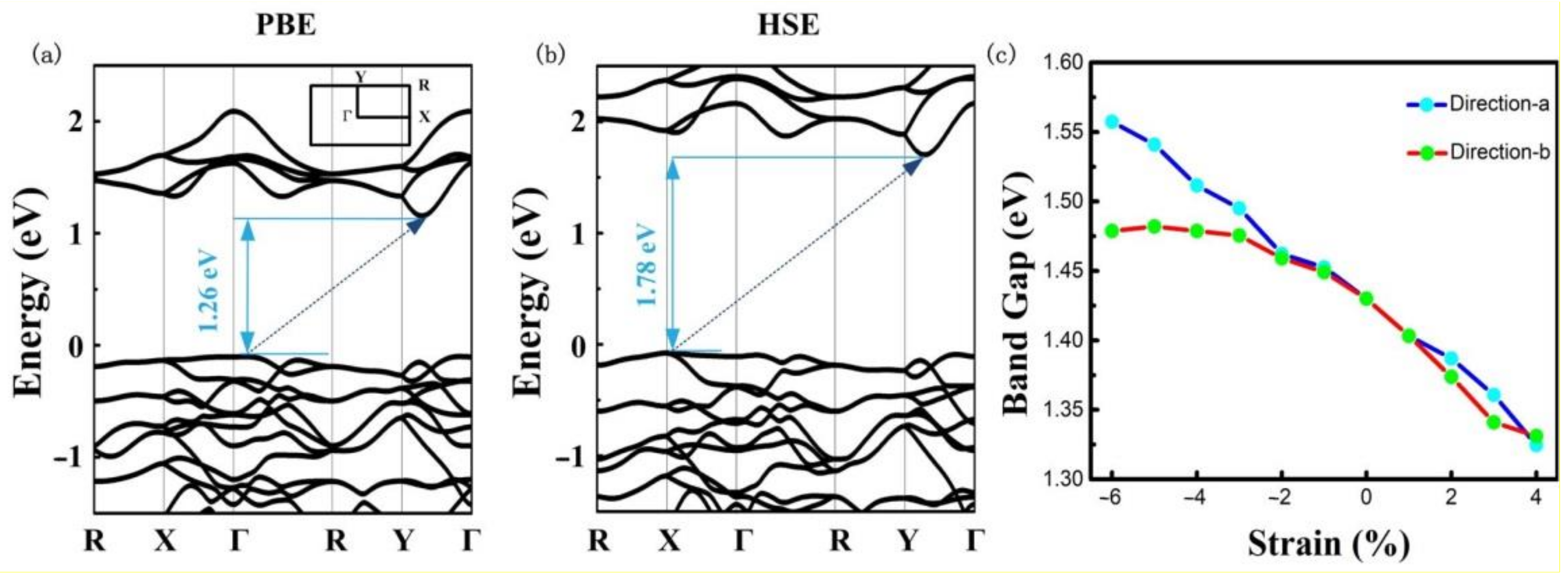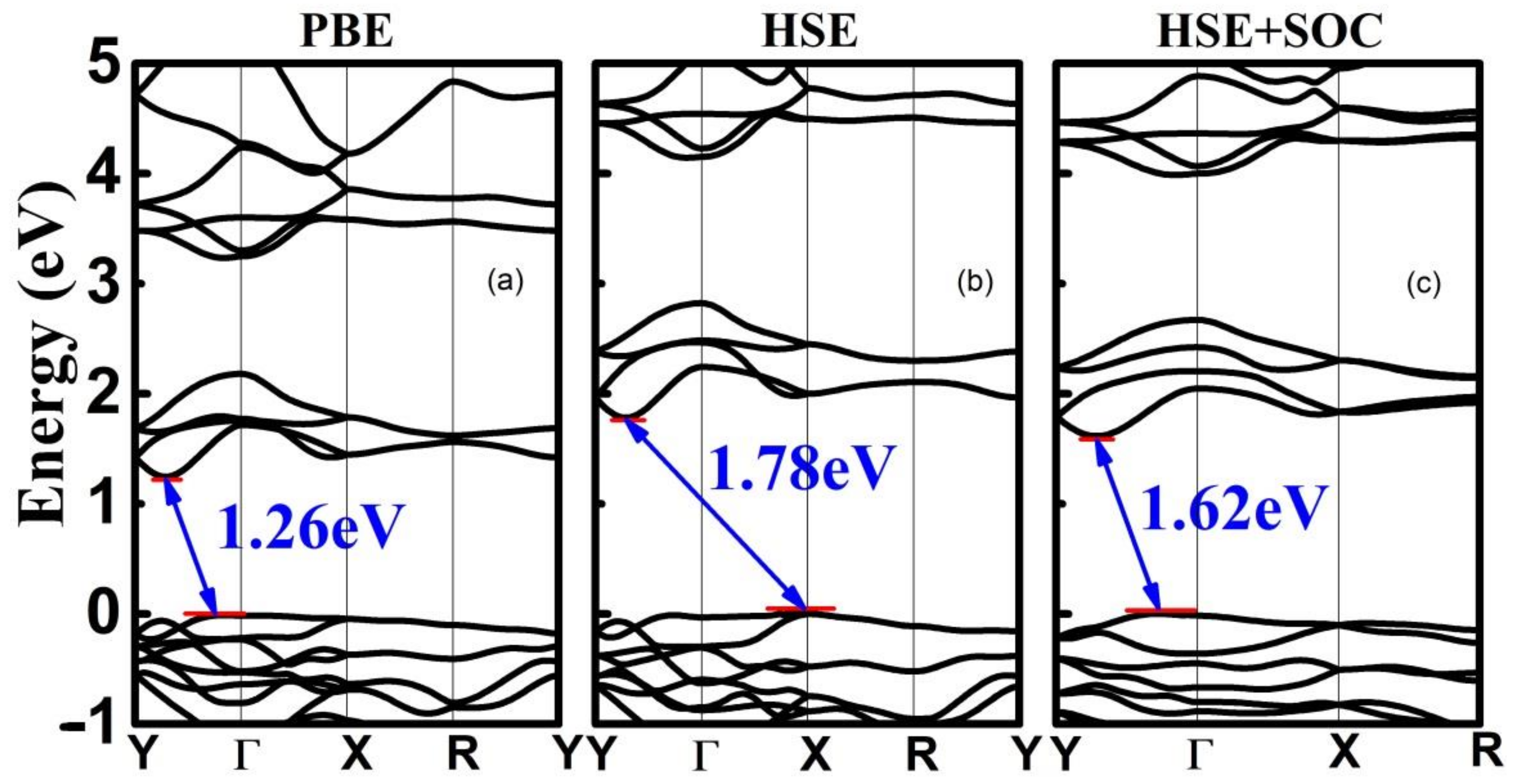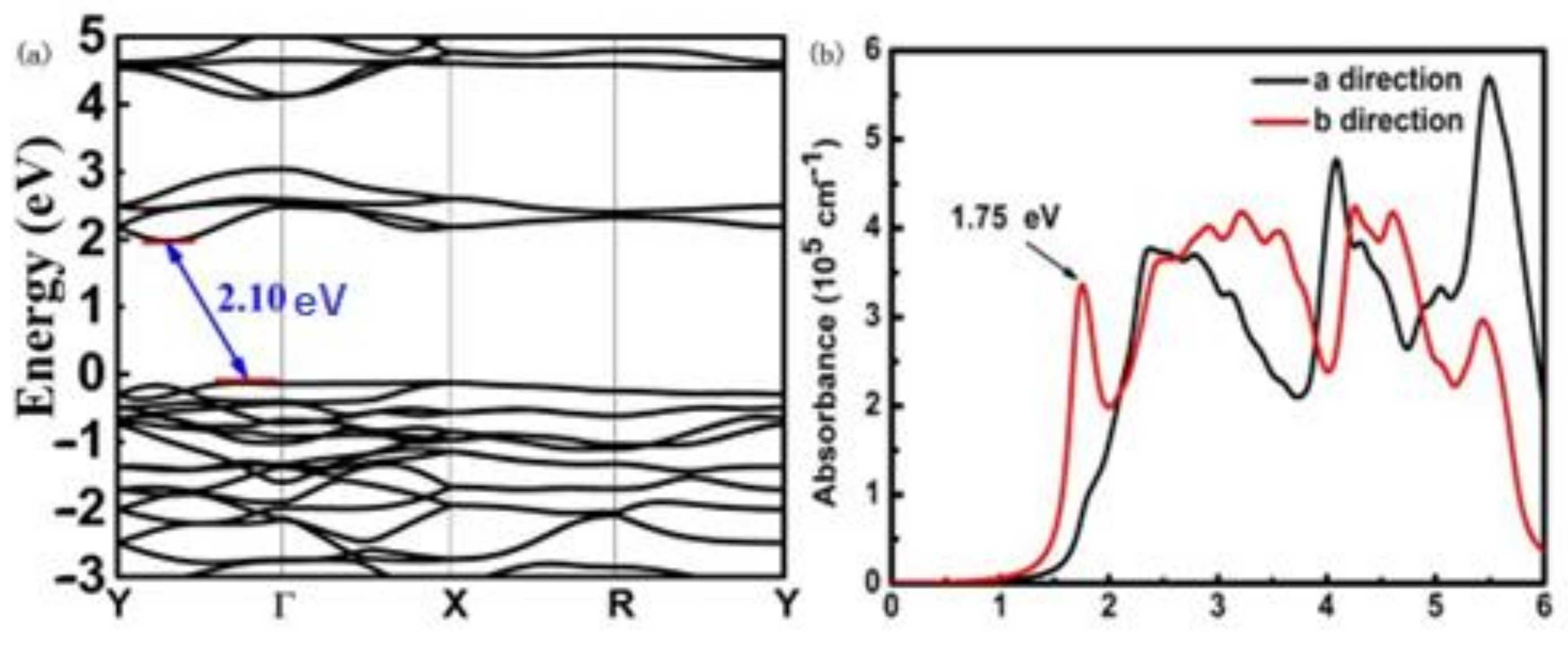Versatile Gold Telluride Iodide Monolayer as a Potential Photocatalyst for Water Splitting
Abstract
:1. Introduction
2. Materials and Methods
3. Results and Discussion
4. Conclusions
Author Contributions
Funding
Institutional Review Board Statement
Informed Consent Statement
Data Availability Statement
Conflicts of Interest
References
- Maeda, K.; Domen, K. Photocatalytic Water Splitting: Recent Progress and Future Challenges. J. Phys. Chem. Lett. 2010, 1, 2655–2661. [Google Scholar] [CrossRef]
- Li, X.; Li, Z.; Yang, J. Proposed Photosynthesis Method for Producing Hydrogen from Dissociated Water Molecules Using Incident Near-Infrared Light. Phys. Rev. Lett. 2014, 112, 018301. [Google Scholar] [CrossRef] [PubMed]
- Zhou, T.; Cao, Z.; Zhang, P.; Ma, H.; Gao, Z.; Wang, H.; Lu, Y.; He, J.; Zhao, Y. Transition metal ions regulated oxygen evolution reaction performance of Ni-based hydroxides hierarchical nanoarrays. Sci. Rep. 2017, 7, 46154. [Google Scholar] [CrossRef] [PubMed] [Green Version]
- Dahan, M.H.; Caspary Toroker, M. Water Oxidation Catalysis with Fe2O3 Constrained at the Nanoscale. J. Phys. Chem. C 2017, 121, 6120–6125. [Google Scholar] [CrossRef]
- Fujishima, A.; Honda, K. Electrochemical Photolysis of Water at a Semiconductor Electrode. Nature 1972, 238, 37–38. [Google Scholar] [CrossRef]
- Linsebigler, A.L.; Lu, G.; Yates, J.T. Photocatalysis on TiO2 Surfaces: Principles, Mechanisms, and Selected Results. Chem. Rev. 1995, 95, 735–758. [Google Scholar] [CrossRef]
- Kim, T.W.; Choi, K.-S. Nanoporous BiVO2 Photoanodes with Dual-Layer Oxygen Evolution Catalysts for Solar Water Splitting. Science 2014, 343, 990–994. [Google Scholar] [CrossRef]
- Jing, D.; Guo, L. A Novel Method for the Preparation of a Highly Stable and Active CdS Photocatalyst with a Special Surface Nanostructure. J. Phys. Chem. B 2006, 110, 11139–11145. [Google Scholar] [CrossRef]
- Mishra, M.; Chun, D.-M. α-Fe2O3 as a photocatalytic material: A review. Appl. Catal. A Gen. 2015, 498, 126–141. [Google Scholar] [CrossRef]
- Gopakumar, A.; Ren, P.; Chen, J.; Rodrigues, B.V.M.; Ching, H.V.; Jaworski, A.; Doorslaer, S.V.; Rokicińska, A.; Kuśtrowski, P.; Barcaro, G. Lignin-Supported Heterogeneous Photocatalyst for the Direct Generation of H2O2 from Seawater. J. Am. Chem. Soc. 2022, 144, 2603–2613. [Google Scholar] [CrossRef]
- Zhang, L.; Zhang, J.; Yu, H.; Yu, J. Emerging S-Scheme Photocatalyst. Adv. Mater. 2022, 34, 2107668. [Google Scholar] [CrossRef]
- Di Bartolomeo, A. Emerging 2D Materials and Their Van Der Waals Heterostructures. Nanomaterials 2020, 10, 579. [Google Scholar] [CrossRef] [Green Version]
- Zhao, P.; Ma, Y.; Lv, X.; Li, M.; Huang, B.; Dai, Y. Two-dimensional III2–VI3 materials: Promising photocatalysts for overall water splitting under infrared light spectrum. Nano Energy 2018, 51, 533–538. [Google Scholar] [CrossRef]
- Fu, C.-F.; Sun, J.; Luo, Q.; Li, X.; Hu, W.; Yang, J. Intrinsic Electric Fields in Two-Dimensional Materials Boost the Solar-to-Hydrogen Efficiency for Photocatalytic Water Splitting. Nano Lett. 2018, 18, 6312–6317. [Google Scholar] [CrossRef]
- Peng, R.; Ma, Y.; Huang, B.; Dai, Y. Two-dimensional Janus PtSSe for photocatalytic water splitting under the visible or infrared light. J. Mater. Chem. A 2019, 7, 603–610. [Google Scholar] [CrossRef]
- Jing, Y.; Ma, Y.; Wang, Y.; Li, Y.; Heine, T. Ultrathin Layers of PdPX (X = S, Se): Two Dimensional Semiconductors for Photocatalytic Water Splitting. Chem. Eur. J. 2017, 23, 13612–13616. [Google Scholar] [CrossRef]
- Jiao, Y.; Ma, F.; Zhou, L.; Ng, Y.H.; Bell, J.; Tretiak, S.; Du, A. Ab initio study of two-dimensional PdPS as an ideal light harvester and promising catalyst for hydrogen evolution reaction. Mater. Today Energy 2018, 7, 136–140. [Google Scholar] [CrossRef]
- Tang, C.; Zhang, C.; Matta, S.K.; Jiao, Y.; Ostrikov, K.; Liao, T.; Kou, L.; Du, A. Predicting New Two-Dimensional Pd3(PS4)2 as an Efficient Photocatalyst for Water Splitting. J. Phys. Chem. C 2018, 122, 21927–21932. [Google Scholar] [CrossRef]
- Wei, Y.; Ma, Y.; Wei, W.; Li, M.; Huang, B.; Dai, Y. Promising Photocatalysts for Water Splitting in BeN2 and MgN2 Monolayers. J. Phys. Chem. C 2018, 122, 8102–8108. [Google Scholar] [CrossRef]
- Qiao, M.; Liu, J.; Wang, Y.; Li, Y.; Chen, Z. PdSeO3 Monolayer: Promising Inorganic 2D Photocatalyst for Direct Overall Water Splitting without Using Sacrificial Reagents and Cocatalysts. J. Am. Chem. Soc. 2018, 140, 12256–12262. [Google Scholar] [CrossRef]
- Lv, X.; Yu, L.; Li, F.; Gong, J.; He, Y.; Chen, Z. Penta-MS2 (M = Mn, Ni, Cu/Ag and Zn/Cd) monolayers with negative Poisson’s ratios and tunable bandgaps as water-splitting photocatalysts. J. Mater. Chem. A 2021, 9, 6993–7004. [Google Scholar] [CrossRef]
- Wang, B.; Sun, Y.; Yang, G. SiCP4 Monolayer with a Direct Band Gap and High Carrier Mobility for Photocatalytic Water Splitting. J. Phys. Chem. Lett. 2022, 13, 190–197. [Google Scholar] [CrossRef] [PubMed]
- Tang, M.; Wang, B.; Lou, H.; Li, F.; Bergara, A.; Yang, G. Anisotropic and High-Mobility C3S Monolayer as a Photocatalyst for Water Splitting. J. Phys. Chem. Lett. 2021, 12, 8320–8327. [Google Scholar] [CrossRef] [PubMed]
- Fenner, J.; Mootz, D. The crystal structure of gold telluride iodide AuTel. J. Solid State Chem. 1978, 24, 367–369. [Google Scholar] [CrossRef]
- Güler-Kılıç, S.; Kılıç, Ç. Crystal and electronic structure of BiTeI, AuTeI, and PdTeI compounds: A dispersion-corrected density-functional study. Phys. Rev. B 2015, 91, 245204. [Google Scholar] [CrossRef] [Green Version]
- Wang, Y.; Zhang, J.; Balogun, M.-S.; Tong, Y.; Huang, Y. Oxygen vacancy-based metal oxides photoanodes in photoelectrochemical water splitting. Mater. Today Sustain. 2022, 18, 100118. [Google Scholar] [CrossRef]
- Liu, L.; Du, S.; Guo, X.; Xiao, Y.; Yin, Z.; Yang, N.; Bao, Y.; Zhu, X.; Jin, S.; Feng, Z. Water-Stable Nickel Metal–Organic Framework Nanobelts for Cocatalyst-Free Photocatalytic Water Splitting to Produce Hydrogen. J. Am. Chem. Soc. 2022, 144, 2747–2754. [Google Scholar] [CrossRef]
- Berne, B.J.; Ciccotti, G.; Coker, D.F. Classical and Quantum Dynamics in Condensed Phase Simulations; World Scientific: Singapore, 1998. [Google Scholar]
- Kresse, G.; Furthmüller, J. Efficiency of ab-initio total energy calculations for metals and semiconductors using a plane-wave basis set. Comput. Mater. Sci. 1996, 6, 15–50. [Google Scholar] [CrossRef]
- Perdew, J.P.; Burke, K.; Ernzerhof, M. Generalized Gradient Approximation Made Simple. Phys. Rev. Lett. 1996, 77, 3865, reprinted in Phys. Rev. Lett. 1997, 78, 1396. [Google Scholar] [CrossRef] [Green Version]
- Heyd, J.; Scuseria, G.E.; Ernzerhof, M. Hybrid functionals based on a screened Coulomb potential. J. Chem. Phys. 2003, 118, 8207–8215. [Google Scholar] [CrossRef] [Green Version]
- Krukau, A.V.; Vydrov, O.A.; Izmaylov, A.F.; Scuseria, G.E. Influence of the exchange screening parameter on the performance of screened hybrid functionals. J. Chem. Phys. 2006, 125, 224106. [Google Scholar] [CrossRef]
- Jiao, Y.; Zhou, L.; Ma, F.; Gao, G.; Kou, L.; Bell, J.; Sanvito, S.; Du, A. Predicting Single-Layer Technetium Dichalcogenides (TcX2, X = S, Se) with Promising Applications in Photovoltaics and Photocatalysis. ACS Appl. Mater. Interfaces 2016, 8, 5385–5392. [Google Scholar] [CrossRef] [Green Version]
- Wang, P.; Liu, H.; Zong, Y.; Wen, H.; Xia, J.-B.; Wu, H.-B. Two-Dimensional In2X2X′ (X and X′ = S, Se, and Te) Monolayers with an Intrinsic Electric Field for High-Performance Photocatalytic and Piezoelectric Applications. ACS Appl. Mater. Interfaces 2021, 13, 34178–34187. [Google Scholar] [CrossRef]
- Singh, A.K.; Mathew, K.; Zhuang, H.L.; Hennig, R.G. Computational Screening of 2D Materials for Photocatalysis. J. Phys. Chem. Lett. 2015, 6, 1087–1098. [Google Scholar] [CrossRef]
- Grimme, S. Semiempirical GGA-type density functional constructed with a long-range dispersion correction. J. Comput. Chem. 2006, 27, 1787–1799. [Google Scholar] [CrossRef]
- Ehrlich, S.; Moellmann, J.; Reckien, W.; Bredow, T.; Grimme, S. System-Dependent Dispersion Coefficients for the DFT-D3 Treatment of Adsorption Processes on Ionic Surfaces. ChemPhysChem 2011, 12, 3414–3420. [Google Scholar] [CrossRef]
- Blöchl, P.E.; Jepsen, O.; Andersen, O.K. Improved tetrahedron method for Brillouin-zone integrations. Phys. Rev. B 1994, 49, 16223–16233. [Google Scholar] [CrossRef]
- Benedict, L.X.; Shirley, E.L.; Bohn, R.B. Optical Absorption of Insulators and the Electron-Hole Interaction: An Ab Initio Calculation. Phys. Rev. Lett. 1998, 80, 4514–4517. [Google Scholar] [CrossRef] [Green Version]
- Onida, G.; Reining, L.; Rubio, A. Electronic excitations: Density-functional versus many-body Green’s-function approaches. Rev. Mod. Phys. 2002, 74, 601–659. [Google Scholar] [CrossRef] [Green Version]
- Rohlfing, M.; Louie, S.G. Electron-Hole Excitations in Semiconductors and Insulators. Phys. Rev. Lett. 1998, 81, 2312–2315. [Google Scholar] [CrossRef]
- Bernardi, M.; Palummo, M.; Grossman, J.C. Extraordinary Sunlight Absorption and One Nanometer Thick Photovoltaics Using Two-Dimensional Monolayer Materials. Nano Lett. 2013, 13, 3664–3670. [Google Scholar] [CrossRef]
- Albrecht, S.; Reining, L.; Del Sole, R.; Onida, G. Ab Initio Calculation of Excitonic Effects in the Optical Spectra of Semiconductors. Phys. Rev. Lett. 1998, 80, 4510–4513. [Google Scholar] [CrossRef] [Green Version]
- Yang, L.; Deslippe, J.; Park, C.-H.; Cohen, M.L.; Louie, S.G. Excitonic Effects on the Optical Response of Graphene and Bilayer Graphene. Phys. Rev. Lett. 2009, 103, 186802. [Google Scholar] [CrossRef]
- Giannozzi, P.; Baroni, S.; Bonini, N.; Calandra, M.; Car, R.; Cavazzoni, C.; Ceresoli, D.; Chiarotti, G.L.; Cococcioni, M.; Dabo, I.; et al. QUANTUM ESPRESSO: A modular and open-source software project for quantum simulations of materials. J. Phys. Condens. Matter 2009, 21, 395502. [Google Scholar] [CrossRef]
- Malyi, O.I.; Sopiha, K.V.; Persson, C. Energy, phonon, and dynamic stability criteria of two-dimensional materials. ACS Appl. Mater. Interfaces 2019, 11, 24876–24884. [Google Scholar] [CrossRef]
- Jung, J.H.; Park, C.-H.; Ihm, J. A rigorous method of calculating exfoliation energies from first principles. Nano Lett. 2018, 18, 2759–2765. [Google Scholar] [CrossRef]
- Splendiani, A.; Sun, L.; Zhang, Y.; Li, T.; Kim, J.; Chim, C.-Y.; Galli, G.; Wang, F. Emerging photoluminescence in monolayer MoS2. Nano Lett. 2010, 10, 1271–1275. [Google Scholar] [CrossRef]
- Zhou, M.; Duan, W.; Chen, Y.; Du, A. Single layer lead iodide: Computational exploration of structural, electronic and optical properties, strain induced band modulation and the role of spin-orbital-coupling. Nanoscale 2015, 7, 15168–15174. [Google Scholar] [CrossRef]
- Birkmire, R.W.; McCandless, B.E. CdTe thin film technology: Leading thin film PV into the future. Curr. Opin. Solid State Mater. Sci. 2010, 14, 139–142. [Google Scholar] [CrossRef]
- Hu, W.; Lin, L.; Zhang, R.; Yang, C.; Yang, J. Highly Efficient Photocatalytic Water Splitting over Edge-Modified Phosphorene Nanoribbons. J. Am. Chem. Soc. 2017, 139, 15429–15436. [Google Scholar] [CrossRef]
- Zhou, L.; Zhuo, Z.; Kou, L.; Du, A.; Tretiak, S. Computational Dissection of Two-Dimensional Rectangular Titanium Mononitride TiN: Auxetics and Promises for Photocatalysis. Nano Lett. 2017, 17, 4466–4472. [Google Scholar] [CrossRef] [PubMed]
- Tran, V.; Soklaski, R.; Liang, Y.; Yang, L. Layer-controlled band gap and anisotropic excitons in few-layer black phosphorus. Phys. Rev. B 2014, 89, 235319. [Google Scholar] [CrossRef] [Green Version]
- Choi, J.-H.; Cui, P.; Lan, H.; Zhang, Z. Linear Scaling of the Exciton Binding Energy versus the Band Gap of Two-Dimensional Materials. Phys. Rev. Lett. 2015, 115, 066403. [Google Scholar] [CrossRef] [PubMed]
- Zhang, K.-L.; Liu, C.-M.; Huang, F.-Q.; Zheng, C.; Wang, W.-D. Study of the electronic structure and photocatalytic activity of the BiOCl photocatalyst. Appl. Catal. B Environ. 2006, 68, 125–129. [Google Scholar] [CrossRef]






| Bulk (Cal.) | Bulk (Exp.) | Monolayer (Cal.) | |
|---|---|---|---|
| a (Å) | 7.55 | 7.31 | 7.22 |
| b (Å) | 7.85 | 7.62 | 7.42 |
| c (Å) | 7.46 | 7.26 |
Publisher’s Note: MDPI stays neutral with regard to jurisdictional claims in published maps and institutional affiliations. |
© 2022 by the authors. Licensee MDPI, Basel, Switzerland. This article is an open access article distributed under the terms and conditions of the Creative Commons Attribution (CC BY) license (https://creativecommons.org/licenses/by/4.0/).
Share and Cite
Hai, B.; Yang, Z.; Zhou, B.; Zhang, L.; Du, A.; Zhang, C. Versatile Gold Telluride Iodide Monolayer as a Potential Photocatalyst for Water Splitting. Nanomaterials 2022, 12, 1915. https://doi.org/10.3390/nano12111915
Hai B, Yang Z, Zhou B, Zhang L, Du A, Zhang C. Versatile Gold Telluride Iodide Monolayer as a Potential Photocatalyst for Water Splitting. Nanomaterials. 2022; 12(11):1915. https://doi.org/10.3390/nano12111915
Chicago/Turabian StyleHai, Bingru, Zhanying Yang, Bo Zhou, Lei Zhang, Aijun Du, and Chunmei Zhang. 2022. "Versatile Gold Telluride Iodide Monolayer as a Potential Photocatalyst for Water Splitting" Nanomaterials 12, no. 11: 1915. https://doi.org/10.3390/nano12111915
APA StyleHai, B., Yang, Z., Zhou, B., Zhang, L., Du, A., & Zhang, C. (2022). Versatile Gold Telluride Iodide Monolayer as a Potential Photocatalyst for Water Splitting. Nanomaterials, 12(11), 1915. https://doi.org/10.3390/nano12111915





